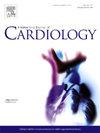不同血糖状态的急性冠状动脉综合征患者空腹血糖与住院死亡率的关系:来自cc - acs项目的发现
IF 3.2
2区 医学
Q2 CARDIAC & CARDIOVASCULAR SYSTEMS
引用次数: 0
摘要
背景:空腹血糖(FBG)是急性冠脉综合征(ACS)患者院内死亡的重要危险因素。本研究探讨不同血糖状态ACS患者空腹血糖水平与预后的关系。方法和结果对CCC-ACS项目(2014-2019)50365例ACS患者的数据进行前瞻性队列研究。根据糖尿病病史和HbA1c水平将患者分为三组:A组(良好)、B组(中等)和C组(不良)血糖状态。空腹血糖与死亡率呈非线性关系。最低的死亡风险与FBG水平相关,分别为4.96 mmol/L (A组)、5.71 mmol/L (B组)和7.44 mmol/L (C组)。FBG水平升高与所有组的死亡风险增加有关:A组(OR: 1.17)、B组(OR: 1.14)和C组(OR: 1.10),均p <;0.001. 该模型显示出中等准确度(A /B组的AUC为0.78,C组的AUC为0.80)·在A组中,FBG每增加一个单位,死亡风险比B组增加1.08倍(OR: 1.08, 95% CI: 1.03-1.14, p = 0.002),比C组增加1.07倍(OR: 1.07, 95% CI: 1.03-1.12, p = 0.002)。结论在ACS患者中,空腹血糖升高是院内死亡的独立危险因素,与血糖状态无关。不同的血糖状态有不同的最佳血糖目标。空腹血糖对死亡率的影响在不同的血糖组有所不同,血糖状态良好的患者随着空腹血糖的升高面临最高的死亡风险。本文章由计算机程序翻译,如有差异,请以英文原文为准。
Association of fasting blood glucose with in-hospital mortality in acute coronary syndrome patients with different glycemic statuses: Findings from the CCC-ACS project
Background
Fasting blood glucose (FBG) is a significant risk factor for in-hospital mortality in acute coronary syndrome (ACS). This study examines the relationship between FBG levels and outcomes in ACS patients with different glycemic statuses.
Methods and results
Data from 50,365 ACS patients in the CCC-ACS Project (2014–2019) were analyzed in a prospective cohort study. Patients were categorized into three groups based on diabetes history and HbA1c levels: Group A (good), Group B (intermediate), and Group C (poor) glycemic status. A non-linear relationship between FBG and mortality was found. The lowest mortality risks were associated with FBG levels of 4.96 mmol/L (Group A), 5.71 mmol/L (Group B), and 7.44 mmol/L (Group C). Elevated FBG levels were linked to increased mortality risk in all groups: Group A (OR: 1.17), Group B (OR: 1.14), and Group C (OR: 1.10), all p < 0.001. The model showed moderate accuracy (AUC: 0.78 for Groups A/B, 0.80 for Group C)·In Group A, each unit increase in FBG raised the mortality risk by 1.08 times compared to Group B (OR: 1.08, 95 % CI: 1.03–1.14, p = 0.002) and by 1.07 times compared to Group C (OR: 1.07, 95 % CI: 1.03–1.12, p = 0.002).
Conclusions
In ACS patients, elevated FBG is an independent risk factor for in-hospital mortality, regardless of glycemic status. Different glycemic statuses have varied optimal glycemic targets. The effect of FBG on mortality differs across glycemic groups, with patients in good glycemic status facing the highest mortality risk as FBG increases.
求助全文
通过发布文献求助,成功后即可免费获取论文全文。
去求助
来源期刊

International journal of cardiology
医学-心血管系统
CiteScore
6.80
自引率
5.70%
发文量
758
审稿时长
44 days
期刊介绍:
The International Journal of Cardiology is devoted to cardiology in the broadest sense. Both basic research and clinical papers can be submitted. The journal serves the interest of both practicing clinicians and researchers.
In addition to original papers, we are launching a range of new manuscript types, including Consensus and Position Papers, Systematic Reviews, Meta-analyses, and Short communications. Case reports are no longer acceptable. Controversial techniques, issues on health policy and social medicine are discussed and serve as useful tools for encouraging debate.
 求助内容:
求助内容: 应助结果提醒方式:
应助结果提醒方式:


